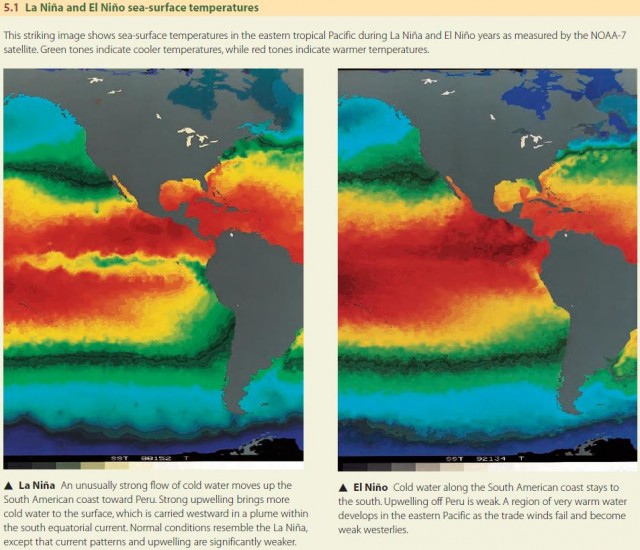El Nino
At irregular intervals of about three to eight years, a remarkable disturbance of ocean and atmosphere occurs in the equatorial Pacific region—El Nino. Its name comes from Peruvian fishermen, who refer to the Corriente del Nino or the “Current of the Christ Child,” to describe an invasion of warm surface water once every few years around Christmas time that greatly depletes their catch of fish. It lasts more than a year, bringing droughts, heavy rainfalls, severe spells of heat and cold, and a high incidence of cyclonic storms to various parts of the Pacific and its eastern coasts.
Normally, the cool Humboldt (Peru) Current flows northward off the South American coast, and then at about the Equator it turns westward across the Pacific as the south equatorial current. The Humboldt Current is fed by upwelling of cold, deep water, bringing with it nutrients that serve as food for marine life. With the onset of El Nino, upwelling ceases, the cool water is replaced by warm, sterile water from the west, and the abundant marine life disappears. In contrast to El Nino is La Nina, in which normal Peruvian coastal upwelling is enhanced, trade winds strengthen, and cool water is carried far westward in an equatorial plume. Figure 5.1 shows two satellite images of sea-surface temperature observed during El Nino and La Nina years.
The major change in sea-surface temperatures that accompanies an El Nino can also shift weather patterns across large regions of the globe. The winter of 1997–1998 experienced one of the strongest El Ninos in a century. Torrential rains drenched Peruvian and Ecuadorean coast ranges, producing mudflows, debris avalanches, and extensive river flooding.

Large portions of Australia and the East Indies went rainless for months, and forest fires burned out of control in Sumatra, Borneo, and Malaysia. In East Africa, Kenya experienced rainfall 1000 mm (80 in.) above normal.
In North America, a series of powerful winter storms lashed the Pacific coast, doing extensive damage in California. Monstrous tornadoes ripped through Florida, killing over 40 people and destroying more than 800 homes. Meanwhile, mild winter conditions east of the Rockies saved vast amounts of fossil fuel while generating an ice storm that left 4 million people without power in Quebec and the northeastern United States. All told, the deranged weather of the El Nino of 1997–1998 did property damage estimated at $33 billion and killed an estimated 2100 people.
The El Nino of 1997–1998 was rapidly followed by the La Nina of 1998–1999. The result was heavier monsoon rains in India and more rain in Australia. In North America, winter conditions were colder than normal in the Northwest and upper Midwest. The eastern Atlantic region endured drought through spring and early summer. The hurricane season of 1998, spawning the monster storm Hurricane Mitch, was the deadliest in the past two centuries.
What effect will global warming have on El Nino? Because global warming raises sea-surface temperatures and increases equatorial rainfall, climatologists think that global warming will enhance the strength and frequency of El Nino events while reducing La Ninas. But the mechanism responsible for the El Nino–La Nina cycle is still not well understood. We'll return to the El Nino–La Nina cycle later in this chapter.